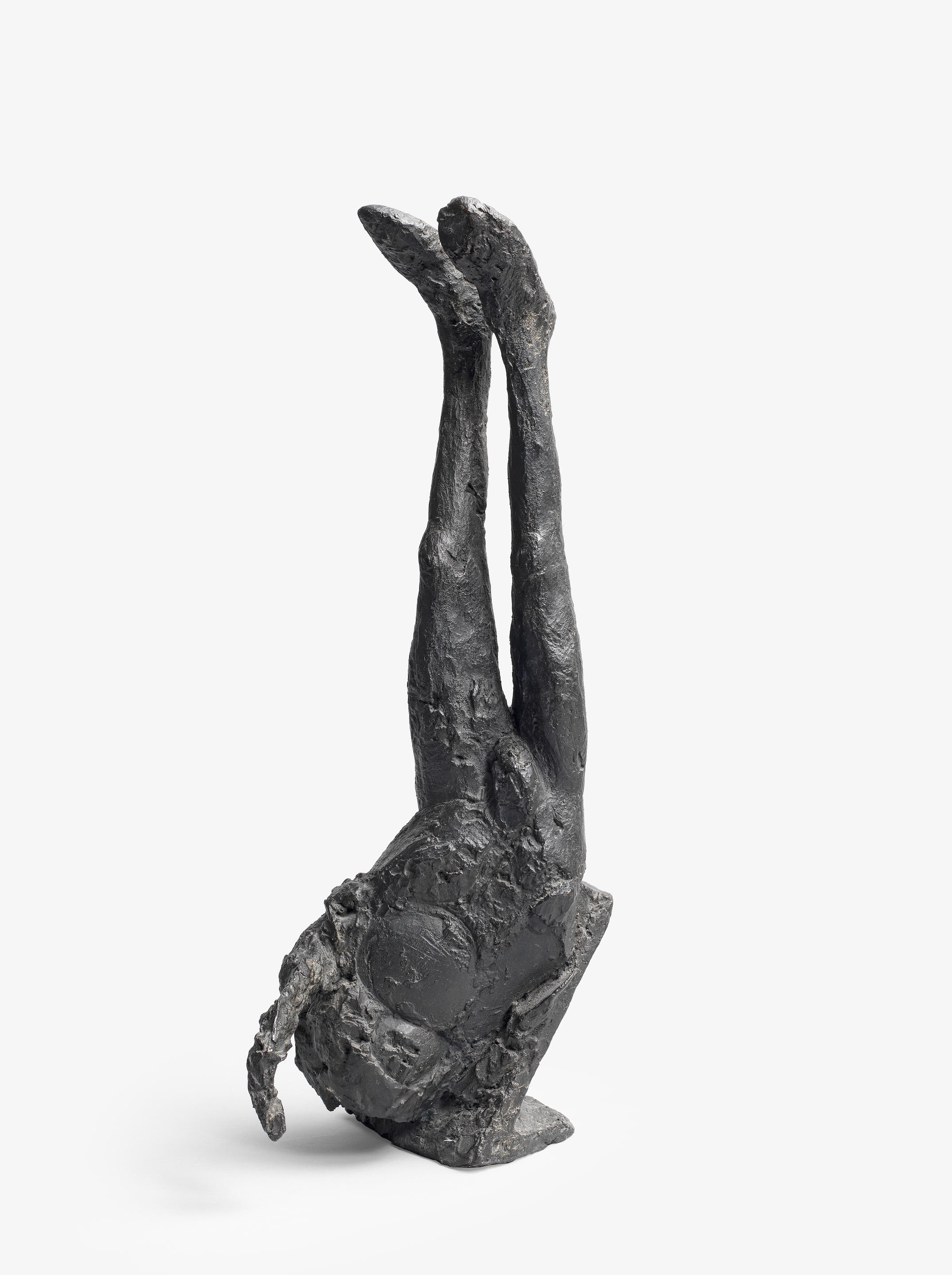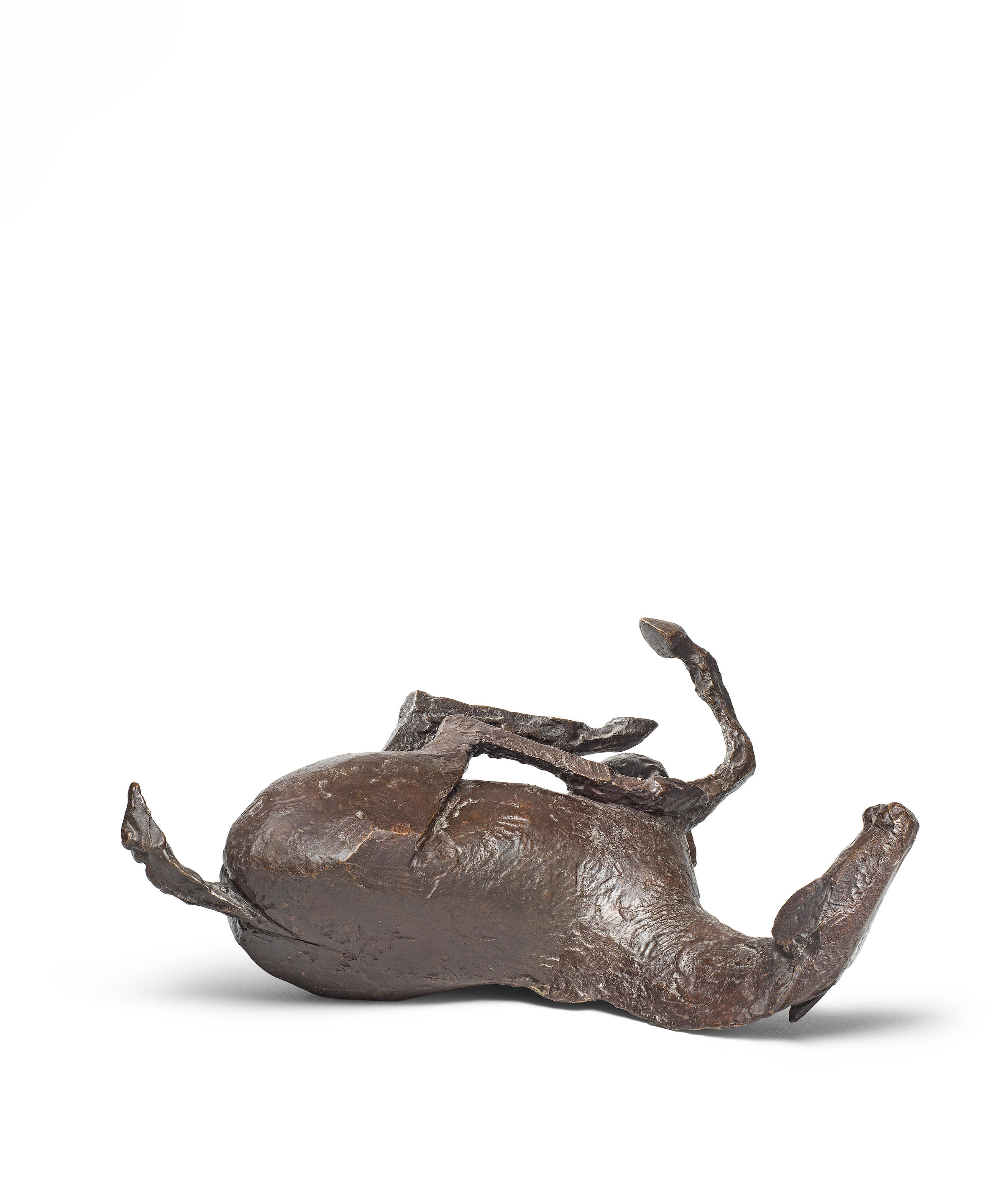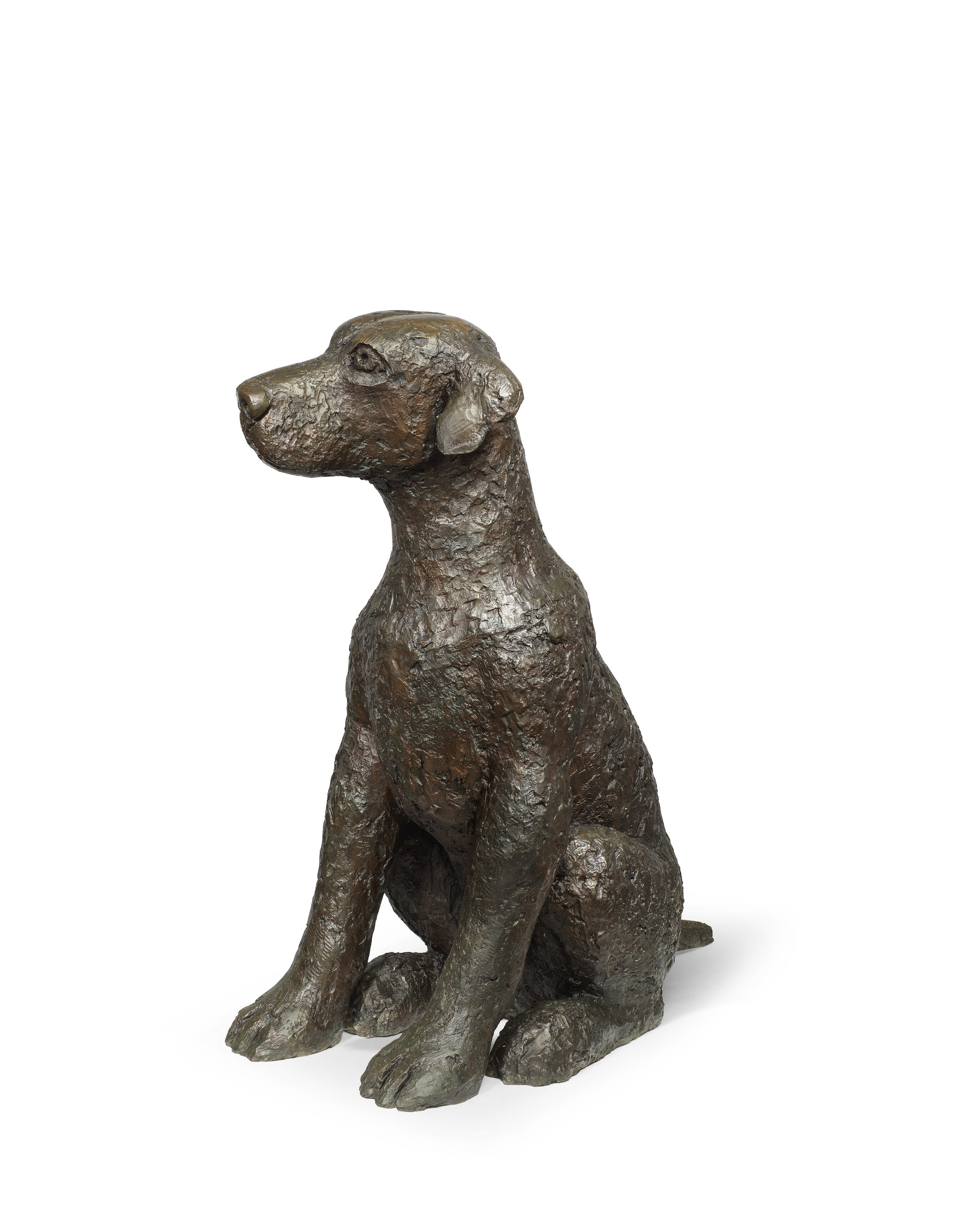Dame Elisabeth Frink D.B.E.; R.A. 1930-1993, Desert Quartet IV,signed and inscribed AC (artists copy) and with foundry stamp Morris Singer Foundry, London,Bronze, with greenish white patina by the sculptor,122cm.; 48ins high, Commissioned in 1986, the present lot is the artists copy (AC) from an edition of six., Born in Thurlow, Suffolk, Frink studied at the Guildford School of Art (1946-1949), and under Willi Soukop at the Chelsea School of Art (1949-1953). Part of a post war group of British sculptors, dubbed the Geometry of Fear school, that included Reg Butler Bernard Meadows Kenneth Armitage and Eduardo Paolozzi Frink’s subject matter included men and especially the male head, birds, dogs, horses and religious motifs, but very seldom any female forms. As one of Britain’s leading sculptors and in recognition of her achievements, Frink was awarded the C.B.E., the D.B.E. and the C.H at various stages in her career, and also several honorary Doctorates. Although she made many drawings and prints, she is best known for her bronze outdoor sculpture, which has a distinctive cut and worked surface. This is created by her adding plaster to an armature, which she then worked back with a chisel and surform. , While living in France from 1967 to 1970, she began a series of threatening, monumental male heads, known as the Goggle Heads which were inspired by the menacing photographs of some of the Algerian leaders wearing sunglasses who took over after the Algerian War of Independence. The monumental male head was further explored in the Tribute Heads created in the 1970’s and finally in the Desert Quartet named after the Tunisian Desert in the late 1980’s. , Julian Spalding in “Frink’s Last Word” writes;,”The huge Desert Quartet heads (1989) are dependent for their effect on lines. These lines are not free-flowing, inscribed arcs, as they are in her study of the Prisoner, but a means of defining eyebrows, eyes, nostrils, ears and lips. Without their sharp outlines, the features would merge into the surrounding sea of flesh. The puckered surface of these heads was new in Frink’s art. It was made by chiselling small, regular notches which fragment the light that falls on them, making the heads, despite their size and weight, appear light and insubstantial, almost shimmering. These delicate, precise repeated marks are a development from Frink’s drawings. The Desert Quartet series was inspired by a visit Frink made to the Tunisian desert. They resonate with sand-dune crispness, softness and vastness. Though totally lacking in pomp, their scale gives them a monumental agelessness that makes one think of the vast marble heads of the late Roman emperors. A closer comparison would be to the great rock-cut Buddhas of China, though Frink’s heads are not serene, smiling down from an elevated state, but troubled with an awareness of their own transience. These are peculiarly unidealised creations, all alike but every one different. Their eyes radiate, like suns, but what they see is human fate. Their light-filled quality has much to do with their surface texture, but its source is their content, the strange sensation we all have, as we look out at the world from our faces, that our heads are somehow transparent.”, Frink herself wrote of the heads:,”I called the Desert Heads that, because I connected them with the feeling that I got in the desert in Tunisia. They portray individuals and also they go together collectively. The way I worked on them was in pairs, moving from one to the other. As I moved to the second pair they became a bit more precise, a bit punchier. For me, the image of the head is a good place to put ideas and sensations. After all, everything goes on in your head. If you think of the past civilisations, there are marvellous head sculptures. Heads have always been very important to me as vehicles for sculpture. A head is infinitely variable. It’s complicated and it’s extremely emotional. Everyone’s emotions are in their fac
Dame Elisabeth Frink D.B.E.; R.A. 1930-1993, Desert Quartet IV,signed and inscribed AC (artists copy) and with foundry stamp Morris Singer Foundry, London,Bronze, with greenish white patina by the sculptor,122cm.; 48ins high, Commissioned in 1986, the present lot is the artists copy (AC) from an edition of six., Born in Thurlow, Suffolk, Frink studied at the Guildford School of Art (1946-1949), and under Willi Soukop at the Chelsea School of Art (1949-1953). Part of a post war group of British sculptors, dubbed the Geometry of Fear school, that included Reg Butler Bernard Meadows Kenneth Armitage and Eduardo Paolozzi Frink’s subject matter included men and especially the male head, birds, dogs, horses and religious motifs, but very seldom any female forms. As one of Britain’s leading sculptors and in recognition of her achievements, Frink was awarded the C.B.E., the D.B.E. and the C.H at various stages in her career, and also several honorary Doctorates. Although she made many drawings and prints, she is best known for her bronze outdoor sculpture, which has a distinctive cut and worked surface. This is created by her adding plaster to an armature, which she then worked back with a chisel and surform. , While living in France from 1967 to 1970, she began a series of threatening, monumental male heads, known as the Goggle Heads which were inspired by the menacing photographs of some of the Algerian leaders wearing sunglasses who took over after the Algerian War of Independence. The monumental male head was further explored in the Tribute Heads created in the 1970’s and finally in the Desert Quartet named after the Tunisian Desert in the late 1980’s. , Julian Spalding in “Frink’s Last Word” writes;,”The huge Desert Quartet heads (1989) are dependent for their effect on lines. These lines are not free-flowing, inscribed arcs, as they are in her study of the Prisoner, but a means of defining eyebrows, eyes, nostrils, ears and lips. Without their sharp outlines, the features would merge into the surrounding sea of flesh. The puckered surface of these heads was new in Frink’s art. It was made by chiselling small, regular notches which fragment the light that falls on them, making the heads, despite their size and weight, appear light and insubstantial, almost shimmering. These delicate, precise repeated marks are a development from Frink’s drawings. The Desert Quartet series was inspired by a visit Frink made to the Tunisian desert. They resonate with sand-dune crispness, softness and vastness. Though totally lacking in pomp, their scale gives them a monumental agelessness that makes one think of the vast marble heads of the late Roman emperors. A closer comparison would be to the great rock-cut Buddhas of China, though Frink’s heads are not serene, smiling down from an elevated state, but troubled with an awareness of their own transience. These are peculiarly unidealised creations, all alike but every one different. Their eyes radiate, like suns, but what they see is human fate. Their light-filled quality has much to do with their surface texture, but its source is their content, the strange sensation we all have, as we look out at the world from our faces, that our heads are somehow transparent.”, Frink herself wrote of the heads:,”I called the Desert Heads that, because I connected them with the feeling that I got in the desert in Tunisia. They portray individuals and also they go together collectively. The way I worked on them was in pairs, moving from one to the other. As I moved to the second pair they became a bit more precise, a bit punchier. For me, the image of the head is a good place to put ideas and sensations. After all, everything goes on in your head. If you think of the past civilisations, there are marvellous head sculptures. Heads have always been very important to me as vehicles for sculpture. A head is infinitely variable. It’s complicated and it’s extremely emotional. Everyone’s emotions are in their fac
.jpg)














Testen Sie LotSearch und seine Premium-Features 7 Tage - ohne Kosten!
Lassen Sie sich automatisch über neue Objekte in kommenden Auktionen benachrichtigen.
Suchauftrag anlegen